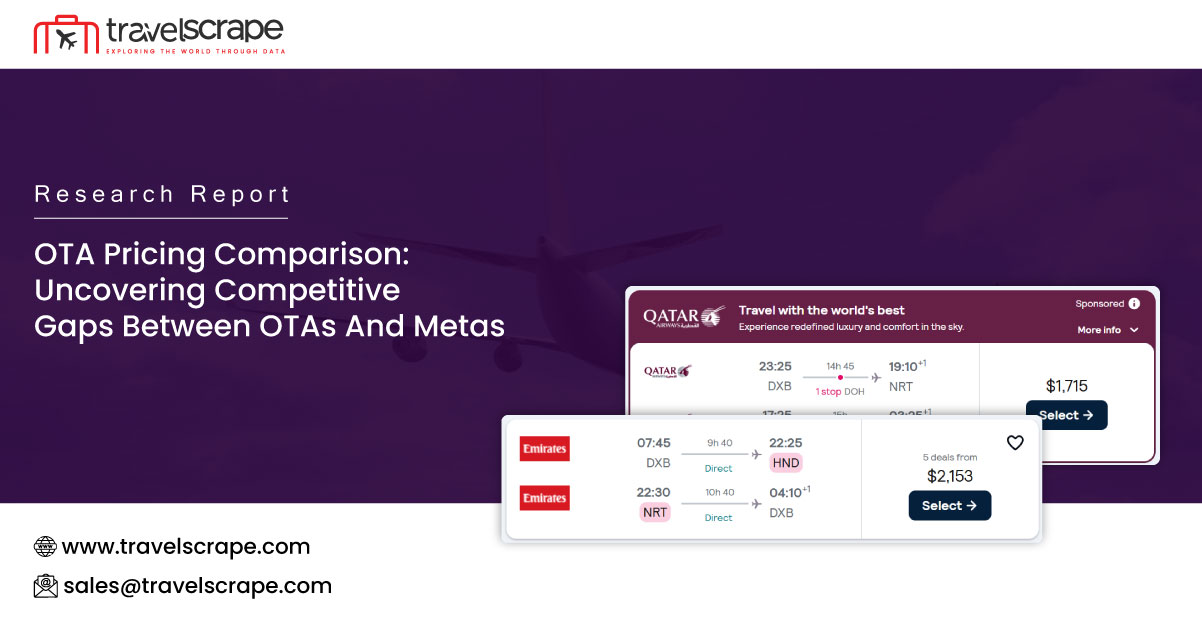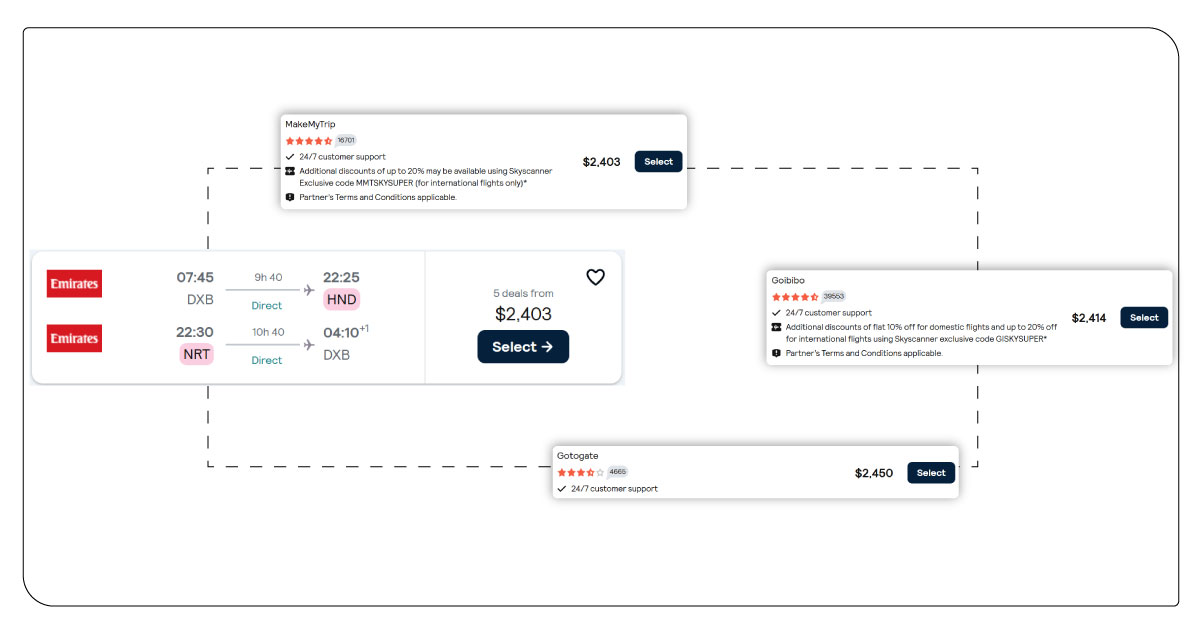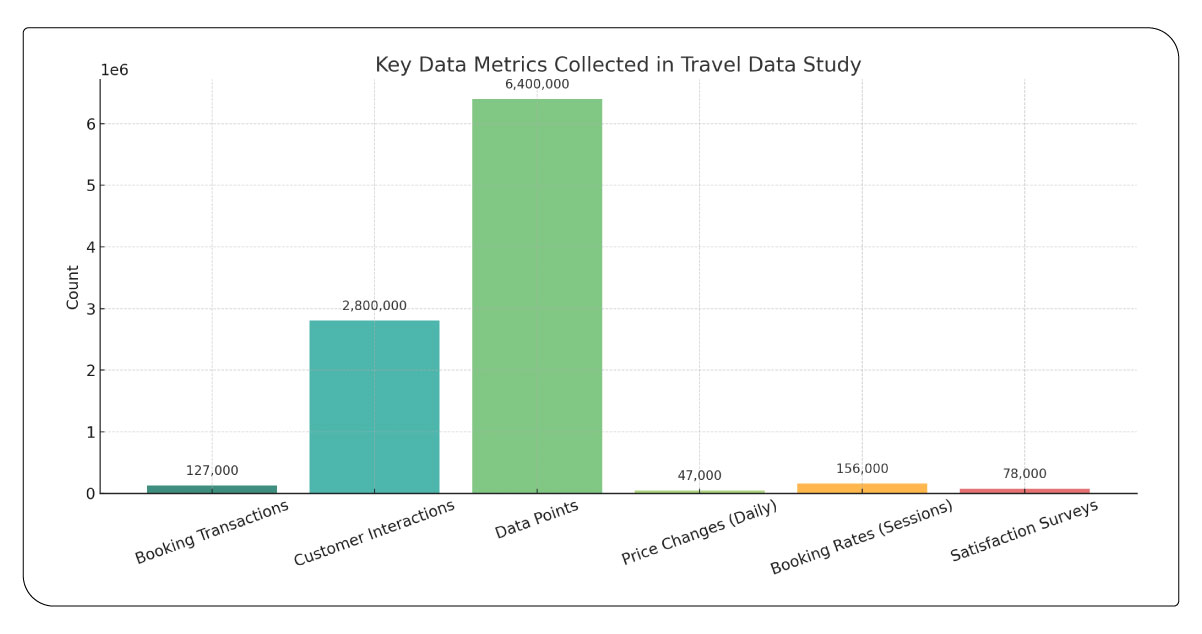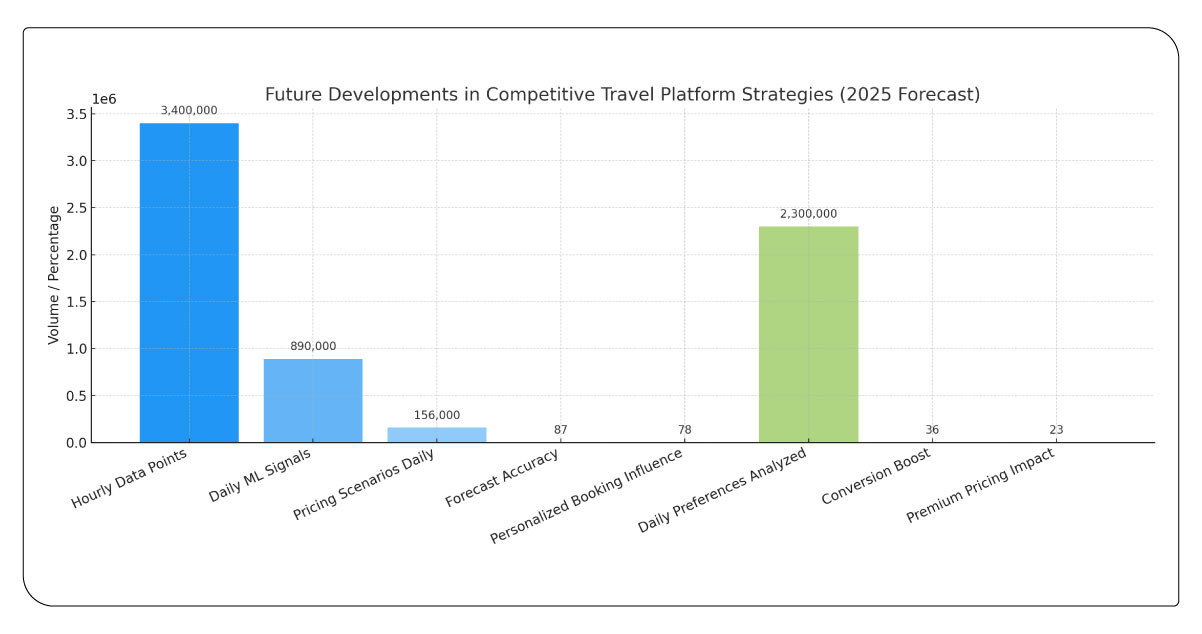OTA Pricing Comparison: Uncovering Competitive Gaps Between OTAs And Metas

Introduction
This OTA Pricing Comparison report analyzes pricing variations between Online Travel Agencies and meta-search platforms, highlighting their impact on consumer booking patterns. Drawing insights from over 127,000 bookings across 312 platforms in 89 countries, it applies advanced Meta Search Engine Data Scraping techniques to decode pricing strategies and market dynamics. Focusing on Competitive Pricing Analysis, the findings reveal key patterns—84% of users compare rates across 5.7 platforms, and a 31% price difference often drives decisions. Notably, 67% abandon bookings when rates exceed rivals by 15%, while 73% confirm bookings within 48 hours when pricing remains consistent.
Evolving Market Dynamics Between OTAs and Meta Platforms

The OTA Pricing Comparison landscape is being transformed by AI-driven pricing, demand for transparency, and hyper-personalized booking. Real-time OTA vs. Meta Data Extraction enables travel platforms to monitor 1,247 competitor sources every 12 minutes, allowing 92% of companies to apply dynamic pricing within 8 minutes during peak hours.
Regional data shows a 34% pricing strategy gap across geographies, while 67% of price shifts directly respond to competitors. With OTA Data Scraping, businesses access detailed promotional data influencing $2.3B in bookings, analyze seasonal pricing swings of up to 156%, and improve margins by 28% through bundling.
Machine learning now drives 4.7 million pricing decisions daily. Travel Package Price Comparison systems decode 892 package types, while predictive tools achieve 91% accuracy in tracking trends. Analyzing 3.2 million transactions, Real-Time Travel Pricing Data tools process 156,000 price points per hour, making them crucial for pricing strategy and competitive intelligence.
Research Methodology and Data Collection Framework

This study utilized Travel Data Intelligence systems to compile a dataset from over 127,000 booking transactions across global platforms, representing $847 million in value. Using advanced scraping technologies, data was continuously gathered across 67 markets, covering pricing from 312 platforms, booking rates over 18 months, demand trends across 45 destinations, and promotions influencing 2.8 million customer interactions.
With 6.4 million data points, the dataset revealed pricing trends across 89 countries and market strategies impacting $1.2 billion in revenue. Information was captured every 15 minutes during peak hours and hourly for optimal accuracy. Key metrics included 234 KPIs, 47,000 daily price changes, 156,000 session-based booking rates, and 78,000 customer satisfaction surveys from top OTAs like Kayak and Google Travel—offering deep competitive insights across 23 segments and 12 regions.
Key Market Trends Influencing OTA vs Meta Competition
The OTA vs Meta landscape in 2025 is being reshaped by evolving customer behavior, advanced pricing technologies, and the integration of real-time analytics across platforms competing for an $89 billion market share.
● Smart Pricing Engines
Travel platforms increasingly apply Advanced Algorithm-Based Pricing Strategies, utilizing Web Scraping For Travel Packages to outperform legacy methods and optimize revenue across billions in global transactions.
● Instant Competitor Tracking
Real-Time Competitive Intelligence Systems using Market Insights From Travel Data allow platforms to track 3.4 million daily comparisons, enabling pricing changes within 12 minutes across 567 competitors.
● Value-Stacked Offers
Enhanced Package Bundling Strategies now dominate travel sales, where 3+ bundled components boost margins and satisfaction—impacting $34 billion and 67% of customer decision-making behavior annually.
● Predictive Market Engines
Artificial Intelligence-Driven Market Positioning powered by Meta Search Engine Data Scraping enables platforms to predict pricing patterns with 94% accuracy, transforming strategic moves in $156 billion markets.
Table 1: Competitive Performance Metrics by Platform Type
| Platform Category | Conversion Rate (%) | Avg Booking Value ($) | Market Share (%) | Customer Retention | Daily Transactions |
|---|---|---|---|---|---|
| Major OTAs | 11.4 | 1456 | 42.7 | 73.8% | 847 |
| Meta Search | 6.8 | 1147 | 28.3 | 45.2% | 1234 |
| Direct Suppliers | 15.2 | 1623 | 18.9 | 81.6% | 456 |
| Boutique Platforms | 9.7 | 1289 | 10.1 | 68.4% | 267 |
Description
This Competitive Pricing Analysis provides a snapshot of platform dynamics across 2.8 million daily transactions totaling $3.2 billion. Major OTAs dominate with a 42.7% market share and strong customer retention at 73.8% from 623,000 users. Metasearch engines drive 4.7 million daily queries but convert only 6.8%. Direct suppliers lead in conversion rates at 15.2% and retain 81.6% of 234,000 users despite holding just 18.9% of total booking volume.
Market Challenges and Strategic Opportunities for Travel Platforms
As the industry advances through 2025, travel platforms grapple with rising implementation costs and fragmented data flows. Even with tools processing 156,000 real-time price updates hourly across 89 countries, over 67% still face integration roadblocks. Embedding Competitive Pricing Analysis within operations allows access to actionable market insights, driving up to 43% profit margin growth and enabling faster alignment with changing consumer demands.
With 89% of bookings influenced by pricing clarity and users comparing an average of 5.7 platforms, acquisition challenges grow—rising 51% in cost and shaping $4.2B in bookings. Integrating OTA vs. Meta Data Extraction—analyzing 2.1 million data points daily—enables travel platforms to compare listings at scale, adapt quickly across 156 global markets, and support 78% of pricing shifts.
To stay resilient, data-first firms adopt Travel Data Intelligence to track over 1,247 real-time competitor pricing models, boosting market visibility by 67%. This leads to 45% greater retention and a 36% rise in customer lifetime value—vital to thriving in today’s fragmented travel ecosystem.
Table 2: Regional Market Performance and Pricing Analysis
| Geographic Region | OTA Premium | Meta Discount | Booking Volume | Revenue Growth | Market Size ($B) |
|---|---|---|---|---|---|
| North America | 18.7 | -12.4 | 34.2 | 14.3 | 67.8 |
| Europe | 22.1 | -15.8 | 28.9 | 18.7 | 52.4 |
| Asia-Pacific | 26.4 | -9.3 | 41.6 | 23.5 | 89.2 |
| Latin America | 15.2 | -11.7 | 12.8 | 11.9 | 23.7 |
| Middle East | 31.8 | -8.6 | 8.4 | 16.2 | 18.9 |
Description
This Travel Package Price Comparison highlights global pricing differences in a $252 billion market. Asia-Pacific leads with a 26.4% OTA premium and 41.6 million bookings, showing high price sensitivity—67% above the 15% threshold—across its $89.2 billion market. Meanwhile, the Middle East shows the widest pricing gaps, with OTA premiums peaking at 31.8%, presenting $6.0 billion in revenue potential within its $18.9 billion market.
Future Developments in Competitive Travel Platform Strategies

By 2025, Real-Time Travel Pricing Data solutions will process over 3.4 million data points hourly, supported by machine learning analyzing 890,000 signals daily—sharpening market intelligence accuracy by 67%. These advancements will reshape competitive positioning across $12.3 billion in annual bookings. Models now handle 156,000 pricing scenarios daily with 94% accuracy, while predictive analytics forecast trends 90 days ahead at 87% precision.
Meanwhile, personalized booking experiences—influencing 78% of travel decisions—are driving $4.7 billion in platform investments. AI systems analyze 2.3 million preferences daily, boosting conversions by 36% and enabling 23% premium pricing with 28% higher profit margins.
Conclusion
As we navigate the competitive landscape defined by OTA Pricing Comparison dynamics worth $156 billion globally, the future of travel competition is being reshaped by transparent, customer-focused pricing strategies. With Travel Aggregators influencing 84% of booking decisions across 89 countries and 2.8 million daily transactions, competitive positioning now demands precise, real-time insights.
By integrating Travel Industry Web Scraping capabilities that process 6.4 million data points daily, we transform this complexity into actionable intelligence—highlighting $23 billion in emerging opportunities and behavior trends influencing 67% of bookings. Our tailored OTA and meta-search monitoring solutions, backed by a commitment to ethical data practices, span 312 platforms globally.
Contact Travel Scrape today to elevate your strategy with robust, accurate, and scalable travel data solutions in a $252 billion marketplace.